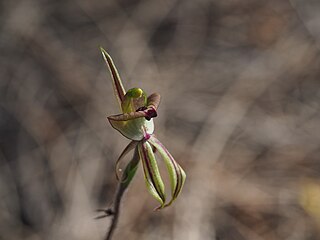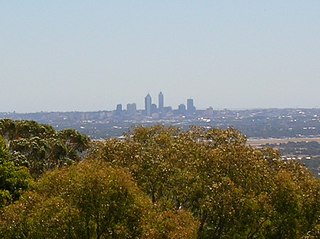
Caladenia attingens, commonly known as mantis orchids, are plants in the orchid family Orchidaceae and are endemic to the south-west of Western Australia. There are three subspecies, each of which has a single hairy leaf and one or two brightly coloured flowers with upswept sepals and a labellum with long, comb-like fringes. The subspecies differ in size, distribution and habitat.

Caladenia brevisura, commonly known as the short-sepalled spider orchid, is a plant in the orchid family Orchidaceae and is endemic to the south-west of Western Australia. It is a common, small-flowered orchid with an erect, hairy leaf and a single greenish flower with red markings, on a flowering stem up to 25 cm (10 in) high. It is found between Ravensthorpe and Israelite Bay.
Caladenia citrina, commonly known as the Margaret River spider orchid, is a plant in the orchid family Orchidaceae and is endemic to the south-west of Western Australia. It has a single erect, hairy leaf and up to three lemon-yellow flowers. It has a narrow distribution in the far south-west corner of Western Australia.
Caladenia corynephora, commonly known as the club-lipped spider orchid, is a plant in the orchid family Orchidaceae and is endemic to the south-west of Western Australia. It has a single erect, hairy leaf and one or two greenish-yellow and red flowers which have a labellum with a club-like tip. It is the only Western Australian caladenia with a clubbed labellum.

Caladenia cruscula, commonly known as the reclining spider orchid is a species of orchid endemic to a small area in the south-west of Western Australia. It has a single hairy leaf and a single cream-coloured flower with a long red fringe on the sides of its labellum.

Caladenia denticulata subsp. denticulata, commonly known as the yellow spider orchid, is a plant in the orchid family Orchidaceae and is endemic to the south-west of Western Australia. It has a single erect, hairy leaf and one or two yellowish flowers which have a white labellum with pale red markings.
Caladenia denticulata subsp. albicans, commonly known as the alabaster spider orchid, is a plant in the orchid family Orchidaceae and is endemic to the south-west of Western Australia. It has a single erect, hairy leaf and one or two pale creamy-white flowers which have a white labellum with red markings. The only known population occurs in a small area near Arrowsmith.
Caladenia denticulata subsp. rubella, commonly known as the clumped spider orchid, is a plant in the orchid family Orchidaceae and is endemic to the south-west of Western Australia. It has a single erect, hairy leaf and one or two dull or pinkish red flowers with prominent dull red markings and with a white labellum with red markings.
Caladenia fluvialis, commonly known as the Brookton Highway spider orchid is a species of orchid endemic to the south-west of Western Australia. It is a recently discovered orchid with a single hairy leaf and one or two cream-yellow flowers with red markings on the labellum.
Caladenia leucochila is a species of orchid endemic to the south-west of Western Australia. It has a single leaf and one or two pale yellow to greenish cream and white flowers with dull red stripes. it is a rare species, only known from near Collie.
Caladenia hopperiana is a species of orchid endemic to the south-west of Western Australia. It has a single leaf and up to four creamy-yellow flowers with faint red markings.

Caladenia attingens subsp. attingens, commonly known as the forest mantis orchid or sneezing spider orchid, is a species of orchid endemic to the south-west of Western Australia. It is a relatively common orchid with a single erect, hairy leaf and one or two green, yellow and red flowers. It is similar to the fringed mantis orchid but has smaller flowers and has a more southerly distribution.

Caladenia attingens subsp. gracillima, commonly known as the small mantis orchid, is a species of orchid endemic to the south-west of Western Australia. It is a relatively common orchid with a single erect, hairy leaf and one or two green, yellow and red flowers. It differs from subspecies attingens in having smaller flowers and a more easterly distribution.
Caladenia attingens subsp. effusa, commonly known as granite mantis orchid, is a subspecies of orchid endemic to the south-west of Western Australia. It has a single erect, hairy leaf and one or two green, yellow and red flowers. It differs from the other subspecies of Caladenia attingens in having smaller flowers with lateral sepals which are not upswept and a labellum which is less than 15 mm (0.6 in) wide.
Caladenia perangusta, commonly known as the Boyup Brook spider orchid, is a species of orchid endemic to the south-west of Western Australia. It is a rare spider orchid with a single hairy leaf and one or two cream-yellow or red flowers with narrow, drooping sepals and petals.
Caladenia pluvialis, commonly known as the Yuna spider orchid, is a species of orchid endemic to the south-west of Western Australia. It is a common spider orchid, especially after winter rains, occurring in a restricted area. It has a single hairy leaf and one or two creamy-coloured flowers. It was formerly included with Caladenia incensa.
Caladenia petrensis, commonly known as the rock spider orchid is a plant in the orchid family Orchidaceae and is endemic to the south-west of Western Australia. It has a single erect, hairy leaf and up to three pale yellow flowers with drooping lateral sepals and petals.
Caladenia saxicola, commonly known as the banded ironstone spider orchid is a plant in the orchid family Orchidaceae and is endemic to the south-west of Western Australia. It has a single erect, hairy leaf and one or two dull creamy-white to pale yellow flowers with spreading lateral sepals and petals.

Caladenia straminichila, commonly known as the Tenterden yellow spider orchid, is a species of orchid endemic to the south-west of Western Australia. It has a single erect, hairy leaf and one or two pale yellow flowers which have a red-striped labellum with short teeth on its sides.
Caladenia validinervia, commonly known as the Lake Muir spider orchid, is a species of orchid endemic to the south-west of Western Australia. It has a single erect, hairy leaf and up to three greenish to creamy white flowers with red stripes on the sepals and petals. The flowers have relatively narrow sepals and petals and a relatively small labellum. It is a rare orchid only known from an area between Rocky Gully and Collie.















